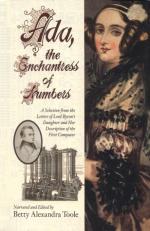|
This section contains 212 words (approx. 1 page at 300 words per page) |
World of Invention on Ada Augusta, Countess of Lovelace
Lovelace was the only legitimate offspring of the poet Lord Byron (1788-1824). A quiet, studious child, she especially liked mathematics . In 1833 she attended a series of lectures on Charles Babbage 's difference engine and was so impressed she asked for a meeting with Babbage himself. The meeting soon developed into a lifelong friendship, and with her contacts with Scottish scientist Mary Somerville (1780-1872) and logician Augustus De Morgan (1806-1842), who instructed her in calculus , Lovelace became a respected mathematician. In 1842 she began translating a study of Babbage's analytical engine (originally published in French by Luigi Menabrea). This work was published the following year as The Sketch of the Analytical Engine and included notes and commentary by Lovelace. Many scholars acknowledge Lovelace's book as an important treatise on Babbage. In addition, Lovelace used her own mathematical talents to encourage Babbage, even suggesting improvements in the design of the analytical engine.
Unfortunately, Lovelace and Babbage ran into financial problems that led to some desperate schemes. To raise money, they built machines capable of playing chess and tic-tac-toe. Their most unusual venture, however, was an attempt to create an infallible system for betting on horse races--an experiment that failed and left both of them heavily in debt. Lovelace died in 1852 of cervical cancer.
|
This section contains 212 words (approx. 1 page at 300 words per page) |


